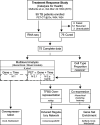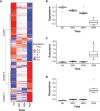The Peripheral Blood Transcriptome Is Correlated With PET Measures of Lung Inflammation During Successful Tuberculosis Treatment
- PMID: 33643286
- PMCID: PMC7902901
- DOI: 10.3389/fimmu.2020.596173
The Peripheral Blood Transcriptome Is Correlated With PET Measures of Lung Inflammation During Successful Tuberculosis Treatment
Abstract
Pulmonary tuberculosis (PTB) is characterized by lung granulomas, inflammation and tissue destruction. Here we used within-subject peripheral blood gene expression over time to correlate with the within-subject lung metabolic activity, as measured by positron emission tomography (PET) to identify biological processes and pathways underlying overall resolution of lung inflammation. We used next-generation RNA sequencing and [18F]FDG PET-CT data, collected at diagnosis, week 4, and week 24, from 75 successfully cured PTB patients, with the [18F]FDG activity as a surrogate for lung inflammation. Our linear mixed-effects models required that for each individual the slope of the line of [18F]FDG data in the outcome and the slope of the peripheral blood transcript expression data correlate, i.e., the slopes of the outcome and explanatory variables had to be similar. Of 10,295 genes that changed as a function of time, we identified 639 genes whose expression profiles correlated with decreasing [18F]FDG uptake levels in the lungs. Gene enrichment over-representation analysis revealed that numerous biological processes were significantly enriched in the 639 genes, including several well known in TB transcriptomics such as platelet degranulation and response to interferon gamma, thus validating our novel approach. Others not previously associated with TB pathobiology included smooth muscle contraction, a set of pathways related to mitochondrial function and cell death, as well as a set of pathways connecting transcription, translation and vesicle formation. We observed up-regulation in genes associated with B cells, and down-regulation in genes associated with platelet activation. We found 254 transcription factor binding sites to be enriched among the 639 gene promoters. In conclusion, we demonstrated that of the 10,295 gene expression changes in peripheral blood, only a subset of 639 genes correlated with inflammation in the lungs, and the enriched pathways provide a description of the biology of resolution of lung inflammation as detectable in peripheral blood. Surprisingly, resolution of PTB inflammation is positively correlated with smooth muscle contraction and, extending our previous observation on mitochondrial genes, shows the presence of mitochondrial stress. We focused on pathway analysis which can enable therapeutic target discovery and potential modulation of the host response to TB.
Keywords: RNA-sequencing; [18F]FDG PET-CT; gene expression; mixed-effect models; pathway analysis; transcription factor binding site; treatment response; tuberculosis.
Copyright © 2021 Odia, Malherbe, Meier, Maasdorp, Kleynhans, du Plessis, Loxton, Zak, Thompson, Duffy, Kuivaniemi, Ronacher, Winter, Walzl, Tromp and the Catalysis TB-Biomarker Consortium.
Conflict of interest statement
The authors declare that the research was conducted in the absence of any commercial or financial relationships that could be construed as a potential conflict of interest.
Figures





Similar articles
-
[Screening and preliminary validation of biomarkers in sputum-negative pulmonary tuberculosis based on positron emission tomography/computed tomography and transcriptomics].Zhonghua Jie He He Hu Xi Za Zhi. 2022 Jun 12;45(6):567-572. doi: 10.3760/cma.j.cn112147-20211207-00864. Zhonghua Jie He He Hu Xi Za Zhi. 2022. PMID: 35658381 Chinese.
-
Evaluation of the diagnostic efficacy of 18 F-Fluorine-2-Deoxy-D-Glucose PET/CT for lung cancer and pulmonary tuberculosis in a Tuberculosis-endemic Country.Cancer Med. 2020 Feb;9(3):931-942. doi: 10.1002/cam4.2770. Epub 2019 Dec 13. Cancer Med. 2020. PMID: 31837121 Free PMC article.
-
18F-FDG PET/CT as a Noninvasive Biomarker for Assessing Adequacy of Treatment and Predicting Relapse in Patients Treated for Pulmonary Tuberculosis.J Nucl Med. 2020 Mar;61(3):412-417. doi: 10.2967/jnumed.119.233783. Epub 2019 Aug 26. J Nucl Med. 2020. PMID: 31451489
-
Towards more accurate 18F-fluorodeoxyglucose positron emission tomography (18F-FDG PET) imaging in active and latent tuberculosis.Int J Infect Dis. 2020 Mar;92S:S85-S90. doi: 10.1016/j.ijid.2020.02.017. Epub 2020 Feb 27. Int J Infect Dis. 2020. PMID: 32114199 Review.
-
Nuclear medicine imaging in tuberculosis using commercially available radiopharmaceuticals.Nucl Med Commun. 2012 Jun;33(6):581-90. doi: 10.1097/MNM.0b013e3283528a7c. Nucl Med Commun. 2012. PMID: 22422098 Review.
Cited by
-
Inclusion of patient-centered, non-microbiological endpoints and biomarkers in tuberculosis drug trials.Front Antibiot. 2025 May 22;4:1570989. doi: 10.3389/frabi.2025.1570989. eCollection 2025. Front Antibiot. 2025. PMID: 40475250 Free PMC article. Review.
-
Tuberculosis Treatment Monitoring and Outcome Measures: New Interest and New Strategies.Clin Microbiol Rev. 2022 Sep 21;35(3):e0022721. doi: 10.1128/cmr.00227-21. Epub 2022 Mar 21. Clin Microbiol Rev. 2022. PMID: 35311552 Free PMC article. Review.
-
Transcriptome-Based Molecular Networks Uncovered Interplay Between Druggable Genes of CD8+ T Cells and Changes in Immune Cell Landscape in Patients With Pulmonary Tuberculosis.Front Med (Lausanne). 2022 Feb 7;8:812857. doi: 10.3389/fmed.2021.812857. eCollection 2021. Front Med (Lausanne). 2022. PMID: 35198572 Free PMC article.
-
Comparing gene expression profiles of adults with isolated spinal tuberculosis to disseminated spinal tuberculosis identified by 18FDG-PET/CT at time of diagnosis, 6- and 12-months follow-up: classifying clinical stages of spinal tuberculosis and monitoring treatment response (Spinal TB X cohort study).J Orthop Surg Res. 2024 Jun 25;19(1):376. doi: 10.1186/s13018-024-04840-7. J Orthop Surg Res. 2024. PMID: 38918806 Free PMC article.
-
NOS2/miR-493-5p Signaling Regulates in the LPS-Induced Inflammatory Response in the RAW264.7 Cells.Biochem Genet. 2023 Jun;61(3):1097-1112. doi: 10.1007/s10528-022-10297-2. Epub 2022 Nov 30. Biochem Genet. 2023. PMID: 36449151
References
-
- World Health Organization Global tuberculosis report 2019. (2019). p. 283.
Publication types
MeSH terms
Substances
LinkOut - more resources
Full Text Sources

